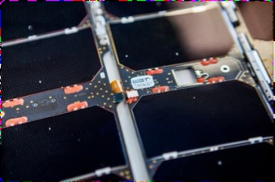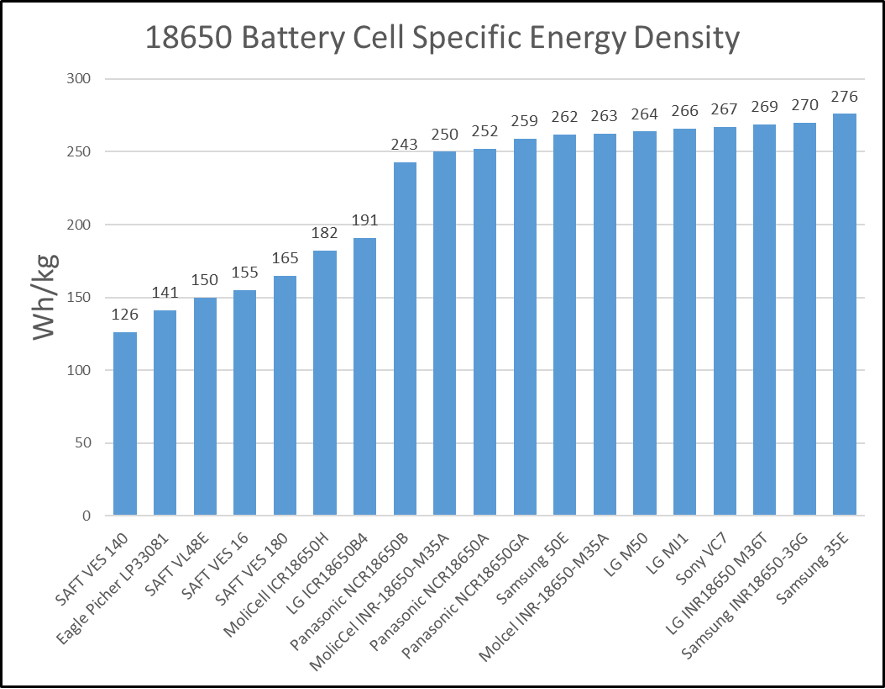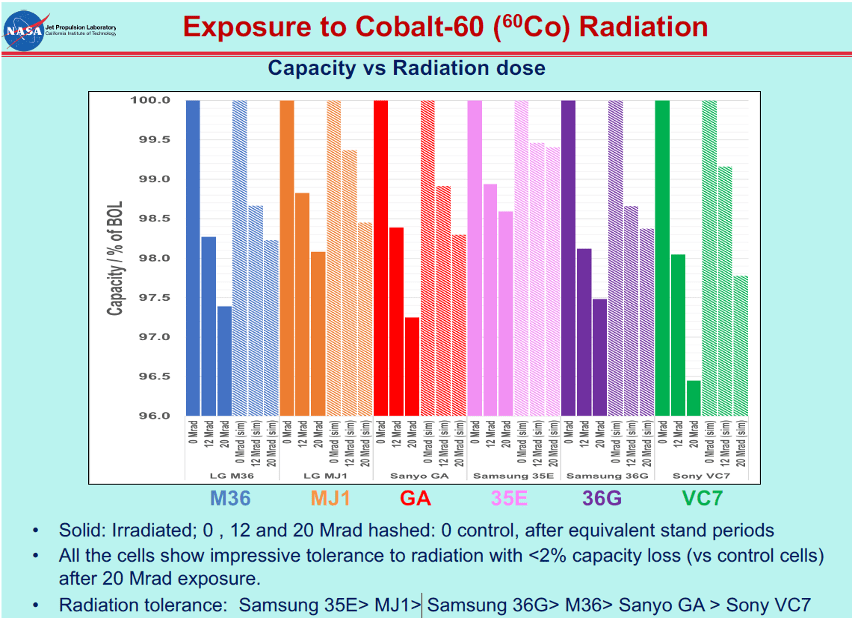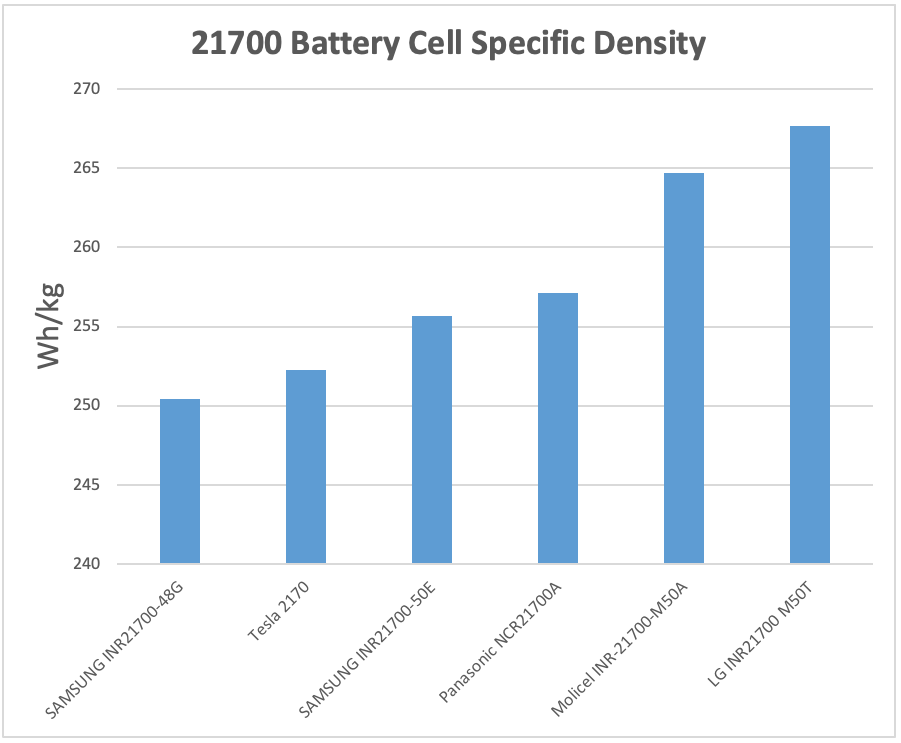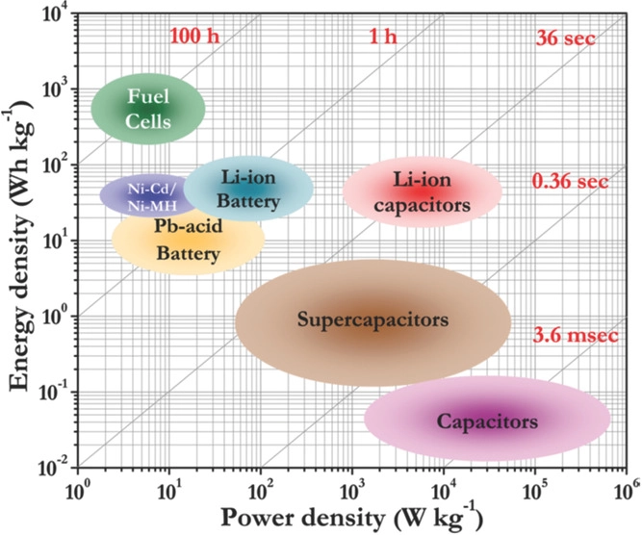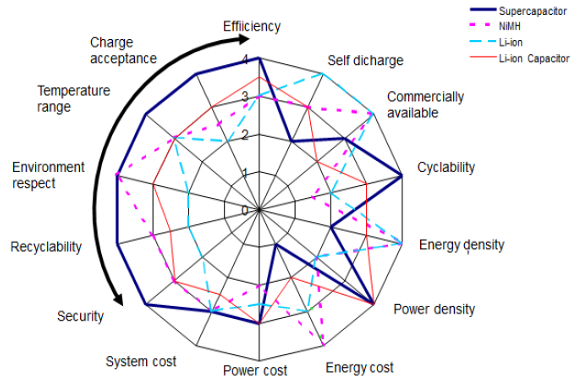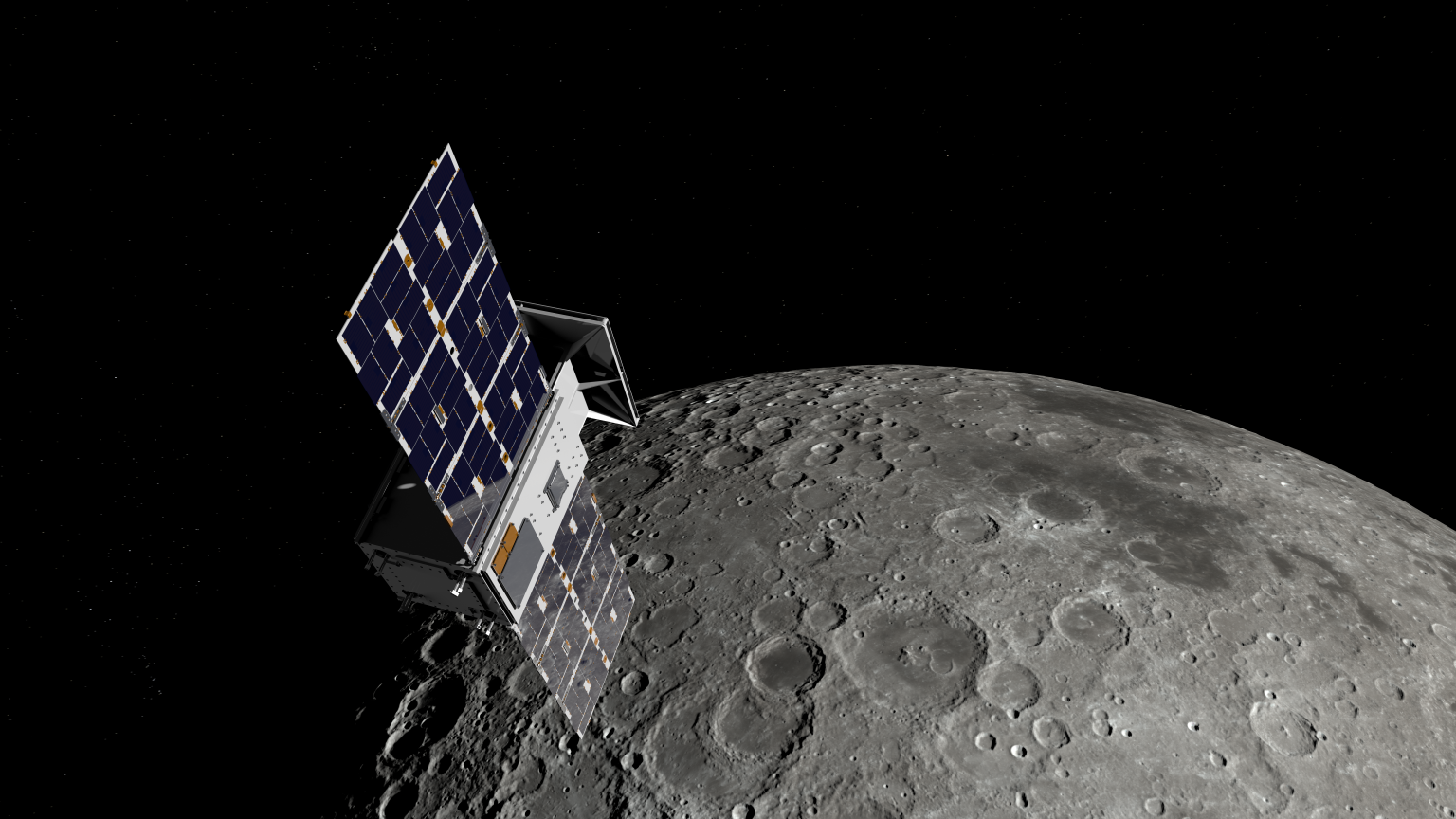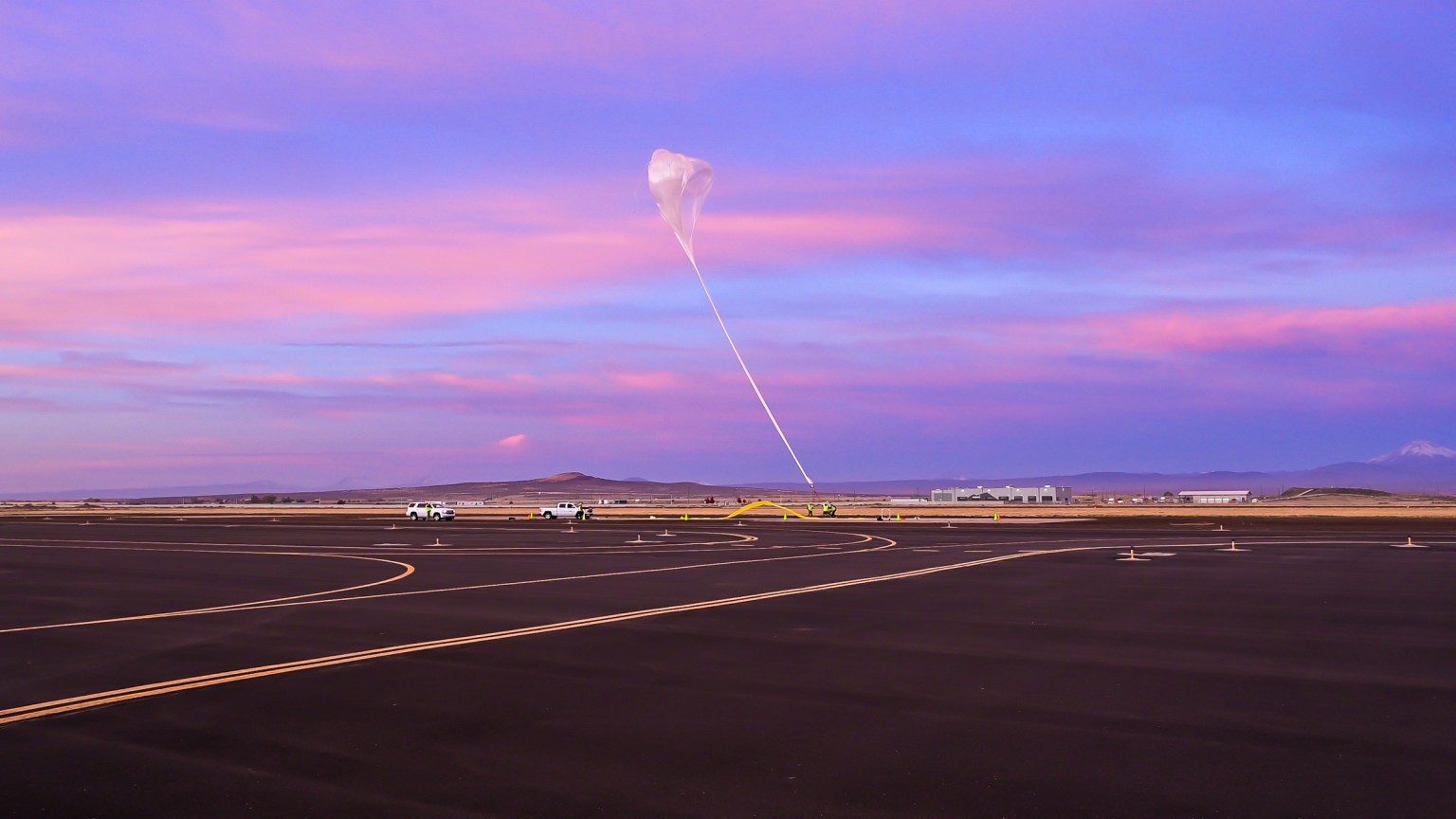Chapter Contents
- Chapter Glossary
- 3.1 Introduction
- 3.2 State-of-the-Art – Power Generation
- 3.3 On the Horizon – Power Generation
- 3.4 State-of-the-Art – Energy Storage
- 3.5 On the Horizon – Energy Storage
- 3.6 State-of-the-Art – Power Management and Distribution
- 3.7 On the Horizon – Power Management and Distribution
- 3.8 Summary
- References
Chapter Glossary
| (AFRL) | Air Force Research Laboratory |
| (BMS) | Battery Management System |
| (BOL) | Beginning-of-Life |
| (CFRPs) | Composite Fiber Reinforced Panels |
| (CIGS) | Cu(In,Ga)Se2 |
| (COTS) | Commercial-off-the-Shelf |
| (EOL) | End-of-Life |
| (EPS) | Electrical Power System |
| (ESA) | European Space Agency |
| (GaN) | Galium Nitride |
| (GRC) | NASA Glenn Research Center |
| (KSC) | Kennedy Space Center |
| (Li-ion) | Lithium-ion |
| (LiCFx) | Lithium carbon monofluoride |
| (LiPo) | Lithium polymer |
| (LiSO2) | Lithium sulfur dioxide |
| (LiSOCl2) | Lithium thionyl chloride |
| (MIL) | Military |
| (QML) | Qualified Manufacturers List |
| (NiCd) | Nickel-cadmium |
| (NiH2) | Nickel-hydrogen |
| (OPV) | Organic Photovoltaic |
| (OSCAR) | Optical Sensors based on carbon materials |
| (PCB) | Printed Circuit Board |
| (PEASSS) | Piezoelectric Assisted Smart Satellite Structure |
| (PET) | polyethylene terephthalate |
| (PMAD) | Power management and distribution |
| (RHUs) | Radioisotopic Heater Units |
| (RTGs) | Radioisotope Thermoelectric Generators |
| (SABER) | Solid-state Architecture Batteries for Enhanced Rechargeability and Safety |
| (SP) | Specific Power |
| (SWaP) | Size, Weight, and Power |
| (TPV) | Thermophotovoltaic |
| (TR) | Thermoradiative |
| (TRL) | Technology Readiness Level |
| (Wh kg-1) | Watt hours per kilogram |
3.1 Introduction
The electrical power system (EPS) is a major, fundamental subsystem that encompasses electrical power generation, storage, and distribution, and commonly comprises a large portion of volume and mass in any given spacecraft. Power generation technologies include photovoltaic cells, panels and arrays, and radioisotope or other thermonuclear power generators. Power storage is typically applied through batteries; either single-use primary batteries or rechargeable secondary batteries. Power management and distribution (PMAD) systems facilitate power control to spacecraft electrical loads and take a variety of forms that are often custom designed to meet specific mission requirements. EPS engineers frequently target a high specific power or power-to-mass ratio (Wh kg−1) when selecting power generation and storage technologies to minimize system mass. The EPS volume is most likely to be the constraining factor for nanosatellites.
CubeSats and SmallSats typically operate in a mild radiative environment for short periods in low-Earth orbits, so stringent qualification standards and high Technology Readiness Level (TRL) tend to not be as relevant as on deep space missions. Therefore, EPS engineers should note some fundamental differences between commercial-off-the-shelf (COTS) parts and space-qualified parts while weighing those differences against spacecraft requirements. Typically, Military or Space (MIL/QML) qualified parts go through a series of specific tests, while COTS go through less stringent ones. For example, Military or Space parts are typically tested and qualified to survive -55°C to 125°C, while the alternative COTS requirement is -40°C to 85°C. The same trend is true for other factors that are a part of the MIL/QML qualification process like radiation, reliability, etc. COTS parts are typically known to have higher performance, while space qualified parts typically have relatively higher reliability. Another key limitation in QML parts is their lack of availability and slow revision timeline. All in all, we find that COTS parts are in many cases more suitable for use in SmallSat designs.
In this chapter, the terms SmallSat and CubeSat are often used in the same context, however, the reader needs to be aware of distinctions between the two types of spacecraft. Please refer to the introduction of this report for more information on the categories of SmallSats. CubeSats fall under the category of both microsatellites and nanosatellites, and CubeSat missions commonly use COTS parts for space applications. Due to their nearly exclusive use in low-Earth orbit applications, CubeSats are more likely to incorporate COTS parts as they typically feature shorter mission lengths, more favorable environmental conditions, and as a result, need less stringent standards when qualifying parts. Knowing the distinction between a CubeSat and a SmallSat is necessary for determining the potential for incorporating COTS parts in a SmallSat design.
The list of organizations/companies in this chapter is not all-encompassing and does not constitute an endorsement from NASA. There is no intention of mentioning certain companies and omitting others based on their technologies or relationship with NASA. The performance advertised may differ from actual performance since the information has not been independently verified by NASA subject matter experts and relies on information provided directly from the manufacturers or available public information. It should be noted that TRL designations may vary with changes specific to the payload, mission requirements, reliability considerations, and/or the environment in which performance was demonstrated. Readers are highly encouraged to reach out to companies for further information regarding the performance and TRL of the described technology.
In this chapter we will review the following categories:
- Sections 3.2 & 3.3: Power Generation, including solar cells, panels and arrays,
- Sections 3.4 & 3.5: Energy Storage, including Li-ion, Lipo, supercapacitors and solid-state batteries, and
- Sections 3.6 & 3.7: Power Management, including modular architectures and wireless power transfer and telemetry.
3.2 State-of-the-Art – Power Generation
Power generation on SmallSats is a necessity typically governed by a common solar power architecture (solar cells + solar panels + solar arrays). As the SmallSat industry drives the need for lower cost and increased production rates of space solar arrays, the photovoltaics industry is shifting to meet these demands. The standardization of solar array and panel designs, deployment mechanisms, and power integration will be critical to meet the desire for large, proliferated constellations.
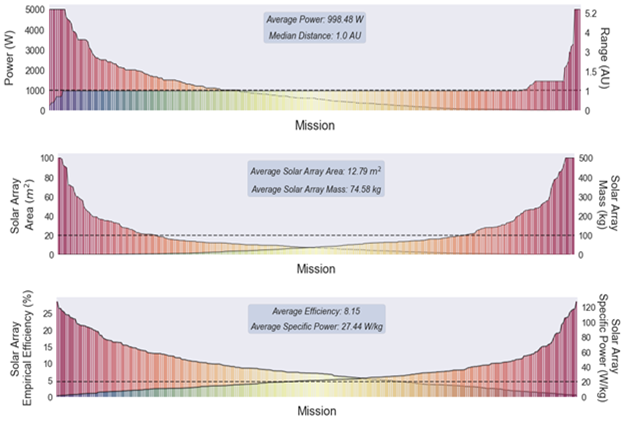
EPS engineers should note beginning-of-life (BOL) vs end-of-life (EOL) performance of the systems as well as their planned testing hours for such systems while on the ground prior to operations. Typically, EPS for SmallSats is over-engineered to handle a dynamic thermal environment, eclipse durations while in LEO, or any other operational scenarios or mission needs while in eclipse at varying sun-angles. Figure 3.1 captures actual space system performances given such wide varying operational conditions for 389 space missions (not only SmallSats) launched since 1989 to 2021 reviewed in the publication (1). The dotted horizontal line indicated where more of the 389 missions surveyed fall under.
When possible, choosing a pre-designed and qualified panel is preferred over designing unique solar panels to reduce the cost and schedule as well as unforeseen design and manufacturing issues. Companies that have the capacity for mass production and automation are rare because space solar arrays, cells, and panels have always been a ‘boutique’ business; however, standardized designs like the OneWeb and StarLink constellations have been appearing more often to meet the demands of highly proliferated constellations.
The following subsections aim to capture the current state of the art and assist EPS engineers, mission designers, system engineers, etc., in designing, reviewing and ultimately constructing and operating power flight systems.
3.2.1 Solar Cells
Solar power generation is the predominant method of power generation on small spacecraft. As of 2021, over 90% of all nanosatellite/SmallSat form factor spacecraft were equipped with solar panels and rechargeable batteries (1). Limitations to solar cell use include diminished efficacy in deep-space applications, no generation during eclipse periods, degradation over mission lifetime (due to aging and radiation), high surface area, mass, and cost. To pack more solar cells into the limited volume of SmallSats and NanoSats, mechanical deployment mechanisms can be added, which may increase spacecraft design complexity and reliability, as well as risk. Photovoltaic cells, or solar cells, are made from thin semiconductor wafers that produce an electric current when exposed to light. The light available to a spacecraft solar array, also called solar intensity, varies as the inverse square of the distance from the Sun. The projected surface area of the panels exposed to the Sun also affects power generation and varies as a cosine of the angle between the panel and the Sun.
While single-junction cells are cheap to manufacture, they carry a relatively low efficiency, usually around 20%, and are not included in this report. Modern spacecraft designers favor multi-junction solar cells made from multiple layers of light-absorbing materials that efficiently convert specific wavelength regions of the solar spectrum into energy, thereby using a wider spectrum of solar radiation (2). The theoretical efficiency limit for an infinite-junction cell is 86.6% in concentrated sunlight (2). However, in the aerospace industry, triple-junction cells are commonly used due to their high efficiency-to-cost ratio compared to other cells.
The current state of the art for space solar cells are multi-junction cells ranging from 3 to 5 junctions based on Group III-V semiconductor elements (like GaAs). SmallSats and CubeSats typically use some of the highest performing cells that provide efficiencies over 32%, even though they have a substantially higher cost than terrestrial silicon solar cells (~20% efficient). Ultimately the size, weight, and volume of smaller satellites may be the determining factor in choosing solar cell technology, rather than solar cell efficiency. Being a life-limiting component on most spacecraft, the EOL performance at operating temperature is critical in evaluating their performance. Common factors that degrade the functionality of solar cells include radiation exposure, coverglass/adhesive darkening, contamination, and mechanical or electrical failure.
This section individually covers small spacecraft targeted cells, fully integrated panels, and arrays. Table 3-1 itemizes small spacecraft solar cell efficiency per the available manufacturers. Note the efficiency may vary depending on the solar cells chosen.
| Table 3-1: Solar Cells Product Table | ||||||||
|---|---|---|---|---|---|---|---|---|
| Company | Cell Name | BOL Efficiency | Voc (V) | Vmp (V) | Jsc (mA/ cm2) | Jmp (mA/ cm2) | Pmp (W/m2) | Ref |
| AZUR Space Germany | Silicon S 32 | 16.8 | 0.628 | 0.528 | 45.8 | 43.4 | 229.2 | (4) |
| 3G30-Adv | 29.5 | 2.7 | 2.411 | 17.2 | 16.71 | 403 | ||
| 4G32-Adv | 31.5 | 3.426 | 2.999 | 15.2 | 14.37 | 431 | ||
| TJ 3G28C | 28 | 2.667 | 2.37 | 16.77 | 16.14 | 1367 | ||
| Rocket Lab USA | ZTJ | 29.5 | 2.726 | 2.41 | 17.4 | 16.5 | 397.7 | (5) |
| ZTJ+ | 29.4 | 2.69 | 2.39 | 17.1 | 16.65 | 397.9 | ||
| ZTJ Omega | 30.2 | 2.73 | 2.43 | 17.4 | 16.8 | 408.2 | ||
| Z4J | 30.0 | 3.95 | 3.54 | 12 | 11.5 | 407.1 | ||
| IMMα | 32.0 | 4.78 | 4.28 | 10.7 | 10.12 | 433.1 | ||
| ZTJM | 29.5 | 2.72 | 2.38 | 17.1 | 16.5 | 392 | ||
| SpectroLab USA | XTJ | 29.5 | 2.633 | 2.348 | 17.76 | 17.02 | 399.6 | |
| XTJ-Prime | 30.7 | 2.715 | 2.39 | 18.1 | 17.4 | 415.9 | (7) | |
| XTE-SF | 32.2 | 2.75 | 2.435 | 18.6 | 17.8 | 433.4 | (6) | |
| XTE-HF | 32.1 | 2.782 | 2.49 | 18 | 17.4 | 427.9 | ||
| XTE-LILT | 31.6 | 2.755 | 2.459 | 18.1 | 17.4 | 427.9 | ||
| UTJ | 28.4 | 2.66 | 2.35 | 17.14 | 16.38 | 384.93 | (8) | |
| TASC | 27 | 2.52 | 2.19 | 32 | 28 | 270 | (9) | |
| ITJ | 26.8 | 2.565 | 2.27 | 16.9 | 16 | 1353 | (10) | |
| Emcore Corporation USA | BTJ | 28.5 | 2.7 | 2.37 | 17.1 | 16.3 | 386 | (11) |
| ZTJ | 29.5 | 2.726 | 2.41 | 17.4 | 16.5 | 397 | ||
3.2.2 Solar Panels & Arrays
Solar panels & arrays are constructed from individual solar cells connected in series to form strings and in parallel to form circuits mounted on a substrate backing (e.g., Figure 3.2). While very low-power CubeSats and SmallSats may only need body-mounted solar panels, most will require more power from deployed solar arrays. The deployed solar arrays for CubeSats and SmallSats are mostly on rigid substrates made of either a printed circuit board (PCB), composite fiber reinforced panels (CFRPs), or an aluminum honeycomb panel.
Deployed solar arrays are often the largest structure on a satellite; the ratio between the size of the deployed solar array and the size of the SmallSat may be much higher compared to other conventionally large spacecraft. The size and fundamental frequency of the solar arrays impact spacecraft pointing, propulsion, and delta-V needed for station keeping. Important considerations for SmallSat solar arrays are deployment mechanisms, deployed frequency, panel specific power, and power density, as well as stowed volume. Most of these metrics are not listed on manufacturer datasheets.
Solar array comparison can be challenging because SmallSat/CubeSat manufacturers who make solar arrays specific to their bus and payload designs often do not report solar array power using the same metrics. Their reported “power” can mean multiple things: power available to the payload, peak power provided by a combination of solar array and battery, or an orbital-specific average power. Reported solar array power (Peak BOL) mainly refers to the peak power of the solar array at the beginning of life, 28°C which is mission independent. Panel stiffness and moment of inertia usually need to be calculated for a specific spacecraft because they are dependent on multiple factors such as the size and mass of the panel, as well as spacecraft size and weight distribution. Examples of commercial solar array and panel products are shown in Table 3-2.
| Table 3-2: Solar Array/Panel Products | |||||
|---|---|---|---|---|---|
| Company Headquarters | Product | Panel Type | Specific Power (W/kg) | Peak BOL Solar Array Power (W) | Ref |
| AAC Clyde Space Sweden | Photon | * | * | 9.25 per 3U-12 Face | (12) |
| Agencia Espacial Civil Ecuatoriana Italy | Deployable Multifunction Solar Array | Deployed Rigid | – | – | |
| Airbus Netherlands The Netherlands | Sparkwing Solar Panel 600x570mm 36V | Body Mounted, 1-3 deployed panels, Rigid | 18 | 88 per panel | (13) |
| Sparkwing Solar Panel 600x700mm 36V | Body Mounted, 1-3 deployed panels, Rigid | 21 | 111 per panel | ||
| Sparkwing Solar Panel 600x820mm 36V | Body Mounted, 1-3 deployed panels, Rigid | 24 | 133 per panel | ||
| Sparkwing Solar Panel 600x965mm 36V | Body Mounted, 1-3 deployed panels, Rigid | 25 | 155 per panel | ||
| Sparkwing Solar Panel 750x820mm 36V | Body Mounted, 1-3 deployed panels, Rigid | 29 | 177 per panel | ||
| Sparkwing Solar Panel 750x965mm 36V | Body Mounted, 1-3 deployed panels, Rigid | 30 | 199 per panel | ||
| Sparkwing Solar Panel 750x1100mm 36V | Body Mounted, 1-3 deployed panels, Rigid | 34 | 243 per panel | ||
| Sparkwing Solar Panel 910x820mm 36V | Body Mounted, 1-3 deployed panels, Rigid | 33 | 221 per panel | ||
| Sparkwing Solar Panel 910x965mm 36V | Body Mounted, 1-3 deployed panels, Rigid | 37 | 265 per panel | ||
| Sparkwing Solar Panel 1000x570mm 36V | Body Mounted, 1-3 deployed panels, Rigid | 29 | 176 per panel | ||
| Sparkwing Solar Panel 1000x1100mm 36V | Body Mounted, 1-3 deployed panels, Rigid | 39 | 309 per panel | ||
| Sparkwing Solar Panel 1070x820mm 36V | Body Mounted, 1-3 deployed panels, Rigid | 37 | 265 per panel | ||
| Sparkwing Solar Panel 600x570mm 50V | Body Mounted, 1-3 deployed panels, Rigid | 19 | 92 per panel | ||
| Sparkwing Solar Panel 600x800mm 50V | Body Mounted, 1-3 deployed panels, Rigid | 22 | 122 per panel | ||
| Sparkwing Solar Panel 600x965mm 50V | Body Mounted, 1-3 deployed panels, Rigid | 25 | 153 per panel | ||
| Sparkwing Solar Panel 600x1100mm 50V | Body Mounted, 1-3 deployed panels, Rigid | 28 | 183 per panel | ||
| Airbus Netherlands The Netherlands | Sparkwing Solar Panel 750x570mm 50V | Body Mounted, 1-3 deployed panels, Rigid | 23 | 122 per panel | |
| Sparkwing Solar Panel 750x800mm 50V | Body Mounted, 1-3 deployed panels, Rigid | 25 | 153 per panel | ||
| Sparkwing Solar Panel 750x965mm 50V | Body Mounted, 1-3 deployed panels, Rigid | 36 | 241 per panel | ||
| Sparkwing Solar Panel 750x1100mm 50V | Body Mounted, 1-3 deployed panels, Rigid | 34 | 244 per panel | ||
| Sparkwing Solar Panel 910x570mm 50V | Body Mounted, 1-3 deployed panels, Rigid | 26 | 153 per panel | ||
| Sparkwing Solar Panel 910x800mm 50V | Body Mounted, 1-3 deployed panels, Rigid | 32 | 214 per panel | ||
| Sparkwing Solar Panel 910x965mm 50V | Body Mounted, 1-3 deployed panels, Rigid | 34 | 244 per panel | ||
| Sparkwing Solar Panel 910x1100mm 50V | Body Mounted, 1-3 deployed panels, Rigid | 40 | 305 per panel | ||
| Sparkwing Solar Panel 1070x570mm 50V | Body Mounted, 1-3 deployed panels, Rigid | 29 | 183 per panel | ||
| Sparkwing Solar Panel 1070x800mm 50V | Body Mounted, 1-3 deployed panels, Rigid | 34 | 244 per panel | ||
| Sparkwing Solar Panel 1070x965mm 50V | Body Mounted, 1-3 deployed panels, Rigid | 39 | 305 per panel | ||
| Sparkwing Solar Panel 1070x1100mm 50V | Body Mounted, 1-3 deployed panels, Rigid | 45 | 366 per panel | ||
| Sparkwing Solar Panel 1230x570mm 50V | Body Mounted, 1-3 deployed panels, Rigid | 31 | 214 per panel | ||
| Sparkwing Solar Panel 1230x800mm 50V | Body Mounted, 1-3 deployed panels, Rigid | 36 | 275 per panel | ||
| Blue Canyon Technologies USA | BCT Solar Array | Body Mount + Deployed Rigid | * | 28 – 42 for 3U / 48-118 for 6U-12U | (14) |
| DHV Technologies Spain | CubeSats Solar Panels | Body Mounted (Polyimide) | 50 | 2 for 1U Face | (15) |
| CubeSats Solar Panels | Body Mounted (Polyimide) | 49 | 4 for 2U Face | ||
| CubeSats Solar Panels | Body Mounted (Polyimide) | 75 | 8 for 3U Face | ||
| CubeSats Solar Panels | Body Mounted (Polyimide) | 68 | 18 for 6U Face | ||
| DHV Technologies Spain | CubeSats Solar Panels | Deployed Rigid (Polyimide) | 42 | 12 for 3U Double Deployable and Body Mounted | |
| CubeSats Solar Panels | Deployed Rigid (Polyimide) | 69 | 57 for 6/12U Double Deployable and Body Mounted | ||
| CubeSats Solar Panels | Deployed Rigid (Polyimide) | 108 | 34 for 3U Quadruple Deployable | ||
| CubeSats Solar Panels | Deployed Rigid (CFRP) | 69 | 68 for 6U Quadruple Deployable | ||
| CubeSats Solar Panels | Body Mounted (Polyimide) | 50 | 2 for 1U Face | ||
| CubeSats Solar Panels | Body Mounted (Polyimide) | 49 | 4 for 2U Face | ||
| Body mounted solar array panel | Sandwich CFRP substrate | 84 | 179 | ||
| Body mounted solar array panel | Low thickness monolithic CFRP substrate | 140 | 96 | ||
| Multiple deployable solar array wing | Sandwich CFRP substrate | 57 | 697 | ||
| EnduroSat Bulgaria | 1U Solar Panel | Deployed Rigid | 63 | 2.4 | (16) |
| 1.5U Solar Panel | Deployed Rigid | 55 | 3.6 | ||
| 3U Solar Panel/Array | Deployed Rigid | 66 | 14.4 | ||
| 6U Solar Panel/Array | Deployed Rigid | 64 | 19.2 | ||
| 8U Solar Panel/Array | Deployed Rigid | 65 | 24.0 | ||
| ExoTerra Resource USA | Fold Out Solar Arrays (FOSA) | Deployed Flexible | 140 | 150 | (17) |
| GomSpace Denmark | Nanopower DSP | Deployed Rigid | * | 1.2 | (18) |
| NanoPower P110 | Fixed | 36.9 – 92 | 1.2 per cell 2.4 | (19) | |
| NanoPower MSP 16 cell | Fixed | 42 | 1.2 per cell 19.2 | (20) | |
| NanoPower TSP Per wing | Deployed Rigid | 60 | 45 | ||
| ISISPACE The Netherlands | Smallsat Solar Panels | Body Mount + Deployed Rigid | 46 | 2.3 per U | (21) |
| Lockheed Martin USA | SmallSat Solar Array | Deployed Rigid with Additively Manufactured Substrate | 53.6 | 170 per panel BOL at 28C | |
| MMA Design USA | Hawk | Deployed Rigid (PCB) | 121 | 36-112 | (22) |
| MMA Design USA | zHawk | Deployed Rigid (PCB) | 95 | 36 | |
| Next-Gen HaWK | Deployed Rigid (PCB) | 100 | 45 – 310 | ||
| NPC Spacemind Italy | SP1X | Body Mounted 1U | 68 | 2.4 | |
| SP1Z | Body Mounted 1U Top | 68 | 2.4 | ||
| SP2X | Body Mounted 2U | 64 | 4.8 | ||
| SP2Z | Body Mounted 2U Top | 64 | 4.8 | ||
| SP3X | Body Mounted 3U | 76 | 8.4 | ||
| SP4X | Body Mounted 4U | 75 | 10.8 | ||
| SP4Z | Body Mounted 4U Top | 58 | 9.6 | ||
| SP6X | Body Mounted 6U | 74 | 19.2 | ||
| SP8X | Body Mounted 8U | 68 | 24 | ||
| SP3X Deployable | Double wing Deployable 3U | 75 | 21.6 | ||
| SP4X Deployable | Double wing Deployable 4U | 58 | 28.8 | ||
| SP6X Deployable | Double wing Deployable 6U | 74 | 57.6 | ||
| SP8X Deployable | Double wing Deployable 8U | 68 | 72 | ||
| Pumpkin Space Systems USA | Dual Articulated Deployable Solar Array | Deployed Rigid | 31 | 135 | (24) |
| Dual-Quad Articulated Deployable Solar Array | Deployed Rigid | 30 | 240 | ||
| Deployable Clamshell Solar Array (DCSA) | Deployed Rigid | 44 | 220 | (25) | |
| Deployable Clamshell Solar Array (DCSA) | Deployed Rigid | 38 | 350 | ||
| Redwire Space USA | ROSA | Flexible PV blanket | 100 | 1000 | (26) |
| Aladdin SmallSat Array | Hybrid Array: Flex Rigid | 80 | 300 | ||
| Sierra Space Corp | Surface Mount Technology Solar Panel | Composite | 2500 | ||
| Spacemanic Czech Republic | RA_Solar_Panels | Triple Junction GaAs | 46 | 2.4 | |
| Space Dynamics Laboratory USA | SDL Modular Solar Panels | Deployed Rigid | 84.5 | 180 per panel | |
| * Available with inquiry to manufacturer ** For SmallSat use | |||||
While solar arrays efficiency has been the prevailing way to characterize solar array performance, discrepancies between theoretical and empirical data indicate that specific power (SP) of the solar array fundamentally governs space mission feasibility and flexibility. Figure 3.3 visualizes the landscape of mission architectures, parameterized by power (adjusted by a factor of squared distance) and mass; the relation between these axes is the SP.
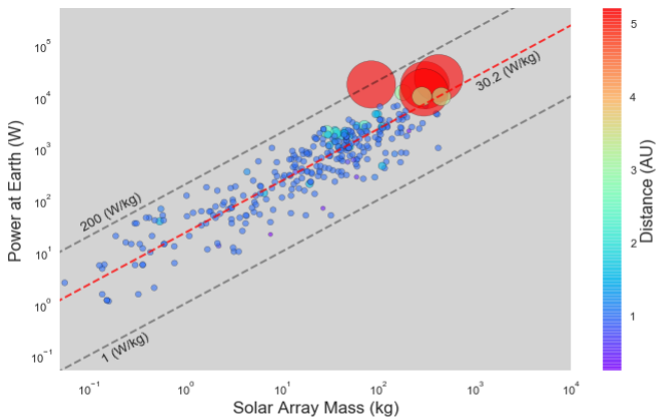
Space missions using solar arrays, regardless of spacecraft mass, are strongly clustered around ~30 W/kg (red dashed line) and are strongly bounded: no missions fly with SP lower than 1 W/kg (lower dashed line), and the maximum empirical SP of this dataset is 200 W/kg (upper dashed line). There are two clearly unoccupied regions: the empty region of high-mass and low-power is of little interest since this is not generally desirable; however, it is interesting that the high-power low-mass regime is empty, indicating that while this is a highly desirable region, it is technologically inaccessible.
With the average mission power consumption of 1000 W and a medium value of 600 W, Figure 3.4 shows what maximal ranges can be achieved with three hypothetical solar array technologies with specific power levels of 10, 100 and 1600 W/Kg (the lines show how the Empirical Specific power changes as a function of range until it reaches the lower limit of 1 W/Kg). The color-coded regions are where maximal surface area of 100 m2 could be contained for power levels of 100, 300, and 1000 W. The areas under the line and within the colored region indicate where current (empirical evidence) and future (theoretical) missions could exist.
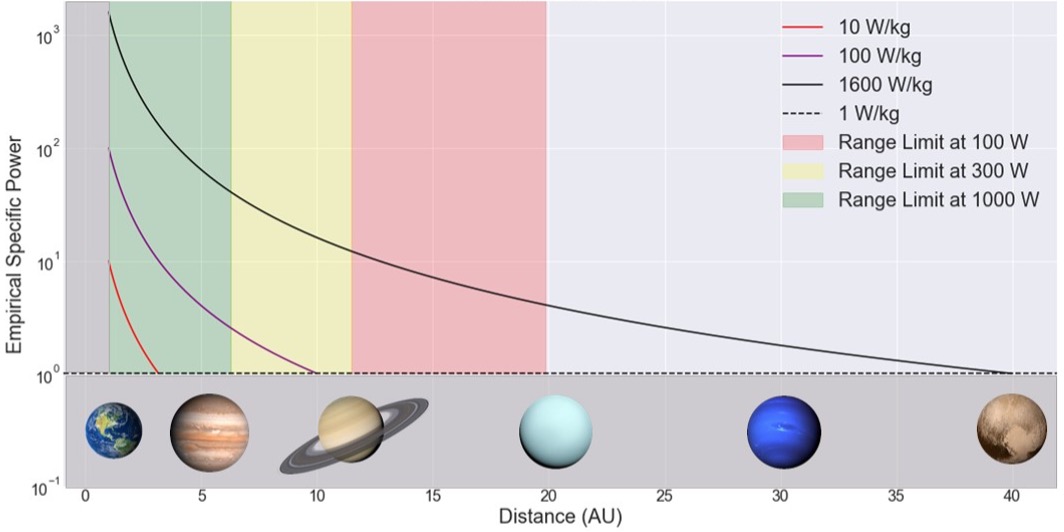
There are two possible approaches to improving solar array specific power: increase generated power or decrease array mass. The former has been the focus of the community for the past 40 years through improving efficiencies. However, even if triple-junction solar cell efficiency improves to the theoretical limit of 68%, the surface area, mass, and storage volume required to support median power requirements for exploration of deep space are beyond the point of feasibility. The mass required from such solar array structures would be measured in thousands of kilograms; clearly a reduction in solar array mass is needed for deep space exploration missions to be feasible.
Future work is needed to reduce solar array mass; deployment mechanism mass could be reduced with light-weight components or alternate configurations (for example, using a tension-based deployment instead of a motor-driven system) to eliminate the requirement for a motor and many spacecraft integration components. Mass reduction for the solar cells themselves can come by reducing cell thickness or increasing flexibility to increase launch vehicle stowage volume. Creating highly foldable arrays may be a desirable solution, with mass decreases possible in both deployment mechanisms and in the design of solar cells.
3.3 On the Horizon – Power Generation
New technologies continue to be developed for space-qualified power generation. Promising technologies applicable to small spacecraft include advanced multi-junction, flexible and organic solar cells, hydrogen fuel cells, and a variety of thermo-nuclear and atomic battery power sources.
3.3.1 Multi-junction Solar Cells
Fraunhofer Institute for Solar Energy Systems has developed different four-junction solar cell architectures that currently reach up to 38% efficiency under laboratory conditions, although some designs have only been analyzed in terrestrial applications and have not yet been optimized (Lackner). Fraunhofer ISE and EV have achieved 33.3% efficiency for a 0.002 mm thin silicon-based multi-junction solar cell, and future investigations are needed to solve current challenges of the complex inner structure of the sub-cells (28). Additionally, SpectroLab has been experimenting with 5- and 6-junction cells with a theoretical efficiency as high as 70% (29).
A collaboration between the Air Force Research Laboratory (AFRL) and SolAero has developed Metamorphic Multi-Junction (IMM-α) solar cells that are less costly with increased power efficiency for military space applications (2). The process for developing IMM-α cells involves growing them upside down, where reversing the growth substrate and the semiconductor materials allow the materials to bond to the mechanical handle, resulting in the more effective use of the solar spectrum (2). A single cell can leverage up to 32% of captured sunlight into available energy. This also results in a lighter, more flexible product. These cells had their first successful orbit in low-Earth orbit in 2018, and since then they have operated in low-Earth orbit on other CubeSat missions.
3.3.2 Flexible Solar Cells
Flexible and thin-film solar cells have an extremely thin layer of photovoltaic material placed on a substrate of glass or plastic. Traditional photovoltaic layers are around 350 microns thick, while thin-film solar cells use layers just one micron thick. This allows the cells to be flexible, lightweight, and cheaper to manufacture because they use less raw material. The performance of commercial flexible CIGS was investigated and reported with the potential for deep space applications at the University of Oklahoma. The authors found promising thin-film solar material using Cu(In, Ga)Se2 (CIGS) solar cells with recorded power conversion efficiencies up to 22.7% (30).
3.3.3 Organic Solar Cells
Another on the horizon photovoltaic technology uses organic or “plastic” solar cells. These use organic electronics or organic polymers and molecules that absorb light and create a corresponding charge. A small quantity of these materials can absorb a large amount of light making them cheap, flexible, and lightweight.
Toyobo Co., Ltd. and the French government research institute CEA have succeeded in making trial organic photovoltaic (OPV) small cells on a glass substrate. Trial OPV modules on a lightweight and thin polyethylene terephthalate (PET) film substrate were demonstrated during their joint research project. Toyobo and CEA succeeded in making the OPV small cells on a glass substrate with the world’s top-level conversion efficiency by optimizing the solvents and coating technique. In a verification experiment under neon lighting with 220 lux, equivalent to the brightness of a dark room, the trial product was confirmed to have attained a conversion efficiency of about 25%, or 60% higher than that of amorphous silicon solar cells commonly used for desktop calculators (31).
In October 2016, the Optical Sensors based on carbon materials (OSCAR) stratospheric-balloon flight test demonstrated organic-based solar cells for the first time in a stratospheric environment. While more analysis is needed for terrestrial or space applications, it was concluded that organic solar energy has the potential to disrupt “conventional” photovoltaic technology (32). Since then, a joint collaborative agreement between the German Aerospace Center and the Swedish National Space Board REXUS/BEXUS has made the balloon payload available for European university student experiments collaborating with the European Space Agency (ESA) (33).
No standardized stability tests are yet available for organic-based solar cell technology, and challenges remain in creating simultaneous environmental influences that would permit an in-depth understanding of organic photovoltaic behavior, but these achievements are enabling progress in organic-based solar cell use. In 2018, Chinese researchers in organic photovoltaics were able to reach 17% power conversion energy using a tandem cell strategy. This method uses different layers of material that can absorb different wavelengths of sunlight, which enables the cells to use more of the sunlight spectrum, which has limited the performance of organic cells (34).
3.3.4 Fuel Cells
Hydrogen fuel cells are appealing due to their small, light, and reliable qualities, and high energy conversion efficiency. They also allow missions to launch with a safe, storable, low-pressure, and non-toxic fuel source. An experimental fuel cell from the University of Illinois that is based on hydrogen peroxide rather than water has demonstrated an energy density of over 1000 Wh kg-1 with a theoretical limit of over 2580 Wh kg-1 (35). This makes them more appealing for interplanetary missions and during eclipse periods, however unlike chemical cells, they cannot be recharged on orbit. Carrying a large fuel tank is not feasible for small or nanosatellite missions. Regenerative fuel cells are currently being researched for spacecraft applications. Today, fuel cells are primarily being proposed for small spacecraft propulsion systems rather than for power sub-systems (36).
3.4 State-of-the-Art – Energy Storage
Solar energy is not always available during spacecraft operations; the orbit, mission duration, distance from the Sun, or peak loads may necessitate stored, onboard energy. Primary and secondary batteries are used for power storage and are classified according to their different electrochemistry. As primary-type batteries are not rechargeable, they are typically used for short mission durations. Silver-zinc is typically used as they are easier to handle and discharge at a higher rate, however, there are also a variety of lithium-based primary batteries that have a higher energy density, including lithium Sulfur dioxide (LiSO2), lithium carbon monofluoride (LiCFx) and lithium thionyl chloride (LiSOCl2) (37).
Secondary-type batteries include nickel-cadmium (NiCd), nickel-hydrogen (NiH2), lithium polymer (LiPo) and lithium-ion (Li-ion), which have been used extensively in the past on small spacecraft. Lithium-based secondary batteries are commonly used in portable electronic devices because of their rechargeability, low weight, and high energy, and have become ubiquitous on spacecraft missions. They are generally connected to a primary energy source (e.g., a solar array) and can provide rechargeable power-on-demand. Each battery type is associated with certain applications that depend on performance parameters, including energy density, cycle life, and reliability (38). Figure 3.5 shows some popular 18650 Lithium-Ion cells and their specific energy densities. While legacy cells had a specific energy of less 200 Wh/kg, latest cells have all exceeded 240 Wh/kg. Traditionally, vendors pack these 18650 cells in various configurations to meet customer needs. Table 3-3 shows a list of battery pack assemblers with their products and TRLs.
This section will discuss the individual chemical cells as well as pre-assembled batteries of multiple connected cells offered from multiple manufacturers. Due to small spacecraft mass and volume requirements, the batteries and cells in this section will be arranged according to specific energy, or energy per unit mass. However, several other factors are worth considering, some of which will be discussed below (37).
| Table 3-3: Battery (Pack) Product Table | |||||||
|---|---|---|---|---|---|---|---|
| Company Headquarters | Product | Volumetric Energy Density [Wh L-1] | Specific Energy [Wh kg-1] | Typical Capacity [Ah] | Max Discharge Rate [A] | Cells Used | Ref |
| AAC Clyde Space Sweden | Optimus | 169.5 | 119.4 | 4.84 | 2.6 | Clyde Space Li-Polymer | (39) |
| Aerospacelab Belgium | BM | 380 | – | 14 | 12 (in / out) | 4 independent battery packs of 8 lithium-ion cells each | |
| Astro Digital | Direct Energy Pack | 187 | 144 | 10 | 50 | 21700 Li-Ion | |
| Argotech Italy | ELEKTRA | 243.5 | 152.5 | 3.4 | 4 | Li-Ion | (40) |
| Berlin Space Technologies Germany | BAT-110 Modular Battery (Nominal 3 strings) | 69.73 | 57.75 | 7.5 | 3 | Li-Fe | |
| EaglePicher Technologies USA | NPD-002271 | 271 | 153.5 | 14.5 | 15 | EaglePicher Li-ion | |
| EnduroSat Bulgaria | EPS IV (BMS) | 222.9 | 178.1 | 33.5 | 100 | Li-Ion | |
| GomSpace Denmark | Nanopower BPX 3000mAh (e.g., 4S-2P) | 262.2 | 172 | 6.0 | 4 | GomSpace NanoPower Li-ion | (42) |
| Nanopower BP4 3000mAh (e.g., 2S-2P) | 239.8 | 168.8 | 6.0 | 4 | GomSpace NanoPower Li-ion | (43) | |
| Nanopower BP8 (8S-1P) | 227.36 | 177.3 | 3.0 | 4 | GomSpace NanoPower Li-ion | ||
| GUMUSH AeroSpace Istanbul | n-ART BAT | 184.5 | 155.1 | 6.01 | 8 | Li-Ion | |
| Ibeos USA | 28V Modular Battery | 151.1 | 109.8 | 8 – 30+ | 20 | * | (44) |
| ISISPACE The Netherlands | PBP-2S1P | 129.1 | 156.5 | 6.4 | 4 | Li-Ion | |
| PBP-2S2P | 327.85 | 160 | 12.8 | 8 | Li-Ion | ||
| PBP-4S1P | 327.85 | 160 | 12.8 | 4 | Li-Ion | ||
| NPC SPACEMIND Italy | KANON | 167 | 250 | 13.6 | 6 | Li-Ion | |
| Saft France | VES16 4S1P | 109.2 | 91 | 4.5 | 4.5 – Cont. 9 – Pulse | SAFT Li-ion | (46) |
| SkyLabs Slovenia | SKY-NANOeps-BMM | 103 | 89 | up to 18 | up to 54 | LiFePO4 | (47) |
| Space Dynamics Laboratory USA | SDL 12V Battery Pack | 144 | 75 | 12.0 | 96 | EaglePicher LP32975 | |
| Vectronic Aerospace GmbH Germany | VLB-X | 101.96 | 74.6 | 12 | 10 – Cont. 20 – Pulse | SAFT Li-Ion | (48) |
| * Available with Inquiry to Manufacturer | |||||||
The chemistry and cell design impacts the volumetric and specific energy densities. This limit represents the total amount of energy available per unit volume or weight, respectively. Current top-of-the-line Li-ion energy cells exhibit ~270 Wh kg-1. Li-ion batteries exhibit lower energy densities due to the inclusion of a battery management system (BMS), interconnects, and sometimes thermal regulation.
There are generally two groups of cells – high energy or high power. High power cells use a low resistance design, such as increasing coating surface area, or multiple points of contact for the current collector to the cell which can allow for lower overall resistance values and a higher rate of discharge. High energy cells work to optimize gravimetric energy densities to obtain the most energy from the cell. Some common methods to increase gravimetric energy densities are via the addition of silicon to the anode, the use of high voltage cathodes, or using a metallic lithium anode. However, these methods can significantly reduce the cyclability of the battery system in exchange for increased energy density.
In general, for space applications, high energy density is important because a battery with high gravimetric energy density will be cheaper to launch into orbit (higher battery capacity per unit mass). However, for some high pulse applications, high-power cells would meet mission needs with less weight. However, energy density is not the only factor to investigate during cell selection. For non-space commercial applications, faster degradation (lower cyclability) of the battery can be beneficial as the electronic device often lasts as long as the battery, and faster turnover of a device may lead to increased revenue.
While space-designed cells typically underperform in energy density, they over-perform in cyclability with many space-designed cells used for longer (~5-15 year) missions. However, not all degradation modes for the lithium-ion trend in a linear fashion, and trends often take time to settle, thus the test results don’t necessarily show the best performing cell until others are further along in testing.
Due to the extremely short mission durations with primary cells, the current state-of-the-art energy storage systems use lithium-ion (Li-ion) or lithium-polymer (LiPo) secondary cells, so this subsection will focus only on these electrochemical compositions, with some exceptions.
3.4.1 Secondary Li-ion and Lipo Batteries
Typically, Li-ion cells deliver an average voltage of 3.6 V, while the highest specific energy obtained is well over 150 Wh kg-1 (37). Unlike electronics, battery cells do not typically show significant damage or capacity losses due to radiation. However, in an experiment done by JPL, some capacity loss is seen among these latest lithium-ion battery cells under a high dosage of Cobalt-60. The results are shown below in Figure 3.6 (49).
In Lithium-ion batteries, repeated charging cycles of the battery eventually result in aging or degradation that affects the overall energy (Watt-hours) that the battery may provide. Many variables impact aging, such as temperature, charge/discharge rate, depth of discharge, storage conditions, etc. Due to the numerous variables that impact aging, lithium-ion batteries are typically put under life test in mission conditions before launch to ensure the battery will meet the specific mission life requirements.
18650 Cells
18650 cylindrical cells (18 x 65 mm) have been an industry standard for lithium-ion battery cells. Many manufacturers have staple high-performance 18650 cells, some of which have flown on multiple spacecraft and are documented in Table 3-4 below.
| Table 3-4: 18650 Cylindrical Cells | ||
|---|---|---|
| Cell | Specific Energy (Wh kg-1) | Flight Heritage |
| LG ICR18650 B3 (2600 mAh) | 191 | NASA’s PhoneSat, NoDES |
| Panasonic NCR18650B (3350 mAh) | 243 | MarCO, ADAPT (Sept 2022*: BioSentinel, Lunar Flashlight, NeaScout) |
| Molicel ICR18650H (2200 mAh) | 182 | NASA’s EDSN mission |
| Canon BP-930s (3000 mAh) | 112 | NASA’s TechEdSat missions |
| LG MJ1 (3500 mAh) | 260 | NASA’s PACE mission |
Cylindrical 18650s have become the most commonly used building blocks for many SmallSats, although prismatic and pouch formats are also available. The lithium-ion industry has seen incremental increases in energy density via the inclusion of silicon in the anode, high voltage cathodes, new electrolyte additives, and improved cell designs.
21700 Cells
21700 (21 x 70 mm) is another type of cylindrical cell that is getting more popular in the automotive industry. Samsung 50E and LG M50 both offer 5000 mAh of energy while the Samsung cells are slightly heavier. The specific energy densities are 262 Wh kg-1 and 264 Wh kg-1 respectively. Although 21700 cells are slightly larger than 18650 cells, they have some of the highest energy densities and could offer some mechanical packaging benefits with fewer cells for certain missions. Figure 3.7 shows various 21700 battery cell specific densities.
4680 Cells
4680 (46 x 80 mm) cylindrical cells are a battery cell form factor that has been introduced to the energy storage scene by Tesla. The larger format cell potentially exacerbates several of the thermal management drawbacks (particularly internal temperature gradients and heterogeneity in current distribution) associated with other common smaller cells, however, to address these drawbacks, Tesla has a “tab-less current collection” method where the current collector foil is used in conjunction with an array of current collectors to reduce ohmic losses and the temperature increases that those losses can cause (50).
When it comes to the manufacturing of Li-ion batteries and battery cells, the companies listed in Table 3-5 are at the forefront of their respective sectors. Although China has some of the largest consumer electronics and EV battery manufacturers, their products are not known for high performance and high reliability and are rarely used in the space industry. Therefore, we do not currently include these products in this report.
| Table 3-5: Commercial and Space Li-ion Manufacturers | |||
|---|---|---|---|
| Commercial Li-ion Manufacturing | Space Li-ion Manufacturing | ||
| Company | Headquarters | Company | Headquarters |
| Panasonic | Japan | EaglePicher Technologies | USA |
| LG Chem | South Korea | Enersys | USA |
| Samsung | South Korea | GS Yuasa | Japan |
| E-one Moli | Taiwan | Saft | France |
| Sony | Japan | Tesla | USA |
3.5 On the Horizon – Energy Storage
In the area of power storage, there are several ongoing efforts to improve storage capability and relative power and energy densities; a Ragone Chart shown in Figure 3.8 illustrates different energy devices (51). For example, the Rochester Institute of Technology and NASA Glenn Research Center (GRC) developed a nanotechnology enabled power system on a CubeSat platform. The power system integrates carbon nanotubes into lithium-ion batteries that significantly increase available energy density. The energy density has exceeded 300 Wh kg-1 during testing, a roughly two-fold increase from the current state of the art. The results in this program were augmented from a separate high-altitude balloon launch in July 2018 organized through NASA GRC, which showed typical charge and discharge behavior on the ascent up to an altitude of 19 km (52). A collaborative project between the University of Miami and NASA Kennedy Space Center (KSC) is aiming to develop a multifunctional structural battery system that uses an electrolytic carbon fiber material that acts as both a load-bearing structure and a battery system. This novel battery system will extend mission life, support larger payloads, and significantly reduce mass. While several panel prototypes have shown successively increased electrochemical performance, further testing of the individual components can improve the accuracy of the computational models (53).
3.5.1 Supercapacitors
While the energy density for supercapacitors, also called ultracapacitors, is low (up to 7 Wh kg-1), they offer a very high-power density (up to 100 kW kg-1), which could be useful for space applications that require power transients. Their fast charge and discharge time, their ability to withstand millions of charge/discharge cycles and a wide range of operational temperatures (-40°C to +70°C), make them a perfect candidate for several space applications (launchers and satellites). This was demonstrated in an ESA Study entitled “High Power Battery Supercapacitor Study” completed in 2010 by Airbus D&S (54). The Nesscap 10F component and a bank of supercapacitors based on the Nesscap 10F component were space-qualified in 2020 after the completion of the ESA Study entitled “Generic Space Qualification of 10F Nesscap Supercapacitors.” Although not likely to replace Li-ion batteries completely, supercapacitors could drastically minimize the need for a battery and help reduce weight while improving performance in some applications. Figure 3.9 shows a comparison chart (55), and Table 3-6 lists differences in Li-ion batteries and supercapacitors (56).
| Table 3-6: Battery-vs-Supercapacitor Specifications | ||
|---|---|---|
| Feature | Li-Ion Battery | Supercapacitor |
| Gravimetric energy (Wh kg-1) | 100 – 265 | 4 – 10 |
| Volumetric energy (Wh L-1) | 220 – 400 | 4 – 14 |
| Power density (W kg-1) | 1,500 | 3,000 – 40,000 |
| Voltage of a cell (V) | 3.6 | 2.7 – 3 |
| ESR (mΩ) | 500 | 40 – 300 |
| Efficiency (%) | 75 – 90 | 98 |
| Cyclability (nb charges) | 500 – 1,000 | 500,000 – 20, 000,000 |
| Life (years) | 5 – 10 | 10 – 15 |
| Self-discharge (% per month) | 2 | 40 – 50 (descending) |
| Charge temperature | 0 to 45°C | -40 to 65°C |
| Discharge temperature | -20C~60°C | -40 to 65°C |
| Deep discharge pb | yes | no |
| Overload pb | yes | no |
| Risk of explosion | yes | no |
| Charging 1 cell | complex | easy |
| Charging cells in series | complex | complex |
| Voltage on discharge | stable | decreasing |
| cost ($) per kW h | 235 – 1,179 | 11,792 |
The lithium-ion capacitor is a promising recent development in the world of energy storage, combining the energy storage capabilities of both lithium-ion batteries as well as double-layered capacitors; they provide a middle ground between power density and energy density, but suffer from limited life-cycles. Some lithium-ion capacitors have minimum specific energy of 200 Wh kg-1 but are limited by a maximum specific power of <350 W kg-1 (58).
3.5.2 Solid-State Batteries
Most of the batteries used in contemporary space applications are lithium-ion batteries that use liquid electrolytes. However, these batteries carry an inherent risk of combustion from physical damage as well as thermal runaway due to overcharge. As a result, spacecraft often carry parasitic weight in the form of cooling systems and housing units. There is a long-standing need for battery designs that improve on energy and power density, as well as safety. NASA’s Solid-state Architecture Batteries for Enhanced Rechargeability and Safety (SABER) project aims to create solid-state batteries that have significantly higher energy than the current state-of-the-art lithium-ion batteries and do not catch fire or lose capacity over time. Current strides in this project include examination and testing on unique battery chemistries including sulfur-selenium and “holey graphene” (57). See Table 3-7 for examples of solid-state batteries.
| Table 3-7: Solid-State Batteries | |||
|---|---|---|---|
| Manufacturer | Product | Wh/kg | Wh/L |
| Solid Power | Silicon EV Cell | 390 | 930 |
| Solid Power | Lithium Metal | 440 | 930 |
| Solid Power | Conversion Reaction Cell | 560 | 785 |
| QuantumScape | LFP (projected) | 230 | 600 |
| QuantumScape | NMC (projected) | 300 | 1000 |
3.5.3 Batteries for Low-Temperature Applications
Typical Li-Ion batteries have an operating temperature range of -20oC to 60oC (3). This may not meet the requirements for missions that require lower operating temperatures. See Table 3-8 for batteries with low-temperature applications.
| Table 3-8: Batteries for Low-Temperature Applications | ||||
|---|---|---|---|---|
| Company/Chemistry | Package | Temperature | Specific Energy | |
| EEMB/Li-Ion (93) | Custom | -40°C ~ 60°C | 193.5 (Wh kg-1) | |
| Tadiran/LiSOCl2 | Custom | -80°C ~ 125°C -40°C ~ 85°C | 1420 Wh/l 1420 Wh/l | |
| GREPOW/LiPo | Custom/Pouch | -40°C ~ 60°C -55°C ~ 50°C | N/A | |
| GREPOW/Li-Ion (LiFePO4) | Custom/Pouch | -40°C ~ 50°C | N/A | |
3.6 State-of-the-Art – Power Management and Distribution
Power management and distribution (PMAD) systems control the flow of power to spacecraft subsystems and instruments and are often custom designed by mission engineers for specific spacecraft power requirements. However, several manufacturers have begun to provide a variety of PMAD devices for inclusion in small spacecraft missions. PMAD not only delivers power coming from energy sources (typically solar arrays in SmallSat applications) but also conditions energy as well, mitigating harmful transient disturbances and fault conditions from propagating downstream and hurting connected loads.
Several manufacturers supply EPS which typically have a main battery bus voltage of 8.2 V but can distribute a regulated 5.0 V and 3.3 V to various subsystems. The EPS also protects the electronics and batteries from off-nominal current and voltage conditions. As the community settles on standard bus voltages, PMAD standardization may follow. Well-known producers of PMAD systems that focus on the small spacecraft market include Pumpkin, GomSpace, Stras Space, and AAC Clyde Space. However, several new producers have begun to enter the PMAD market with a variety of products, some of which are listed below. Table 3-9 lists PMAD system manufacturers; it should be noted that this list is not exhaustive.
Key considerations in determining PMAD device selection often include conversion efficiency, input/output voltage range, output power capabilities, and size, weight, and power (SWaP). These metrics are critical to consider for good SmallSat PMAD designs, but it is important to note that PMAD devices are best chosen to suit the exact application of the SmallSat mission. SmallSat missions are often short and more flexible in terms of risk management than larger satellites, and therefore lend themselves to greater flexibility in design choices. One must leverage the benefits and risks to the mission at hand when choosing COTS PMAD systems, which may include the following:
- COTS PMAD may require less intensive integration and testing but have drawbacks to be addressed in a custom PMAD build
- Unnecessary features and peripherals (e.g., excess switching, fusing, current capability) can greatly increase SWaP metrics on a SmallSat
- Variability in designs of COTS PMAD devices means that important features and protections are not available in all devices (MPPT, Dead-bus protections, redundancy mechanisms, etc.)
Due to the variability of COTS PMAD options, many choice considerations, from internal power management topologies/materials to telemetry and protection options, are either included or omitted from products depending on the manufacturer. Internal power regulation topologies have traditionally been silicon-based, but relatively recent research into the performance improvements of Gallium Nitride (GaN) topologies has increased the number of GaN-based PMAD options in the consumer market with the following benefits over their silicon counterparts:
- Ability to achieve high switching rates and lower switching losses, allowing for the downsizing of inductors and capacitors, and improving SWaP metrics
- Lack of gate oxide layer in GaN-based field-effect transistors yields improvements in overall efficiency
It must also be noted that GaN-based PMAD options are not to be considered as drop-in replacements for silicon-based PMAD options. Despite the number of performance improvements, GaN architectures come with a variety of drawbacks including high complexity of control circuitry and lack of flight heritage.
In looking at the table below, one must note that there is no single COTS PMAD solution that can fit all needs of a mission at hand. In appealing to a broad range of applications, most COTS PMAD devices make sacrifices that can impact important metrics for SmallSats, including SWaP as well as the efficiency and quality of the power being managed. In choosing to use COTS PMAD devices, designers and system architects should be aware of, and try to minimize, unnecessary features not beneficial to the mission.
| Table 3-9: Power Management and Distribution System Products | ||||||||
|---|---|---|---|---|---|---|---|---|
| Company | Product | Mass (kg) | Volume (cm3) | Peak Power Output (W) | Input Voltages (VDC) | Output Voltages (VDC) | Max Efficiency (%) | Ref |
| AAC Clyde Space Sweden | Starbuck Micro | 2.45 | 3968 | 80.4 | 28 | 28 / 5 | 97 | (59) |
| Starbuck Mini | 5.9 | 13133 | 1200 | * | 22-34 / 5 / 8/ 12 / 15 | * | (60) | |
| Starbuck Nano | 0.086 | 140 | * | * | 3.3 / 5/ 12 | * | (61) | |
| Aerospacelab Belgium | PCDU | 1.635 | 1715.5 | 960 | [0; 65] V | 5V bus voltage [4.75, 5.25] V 12V bus voltage [11.4, 12.6] | >97 | |
| Argotec Italy | PCDU VOLTA | 0.97 | 600 | 100 | 18-22 | 1x 3.3 V, 1x 5 V, and 2x 12 V | 75 | (62) |
| PCDU ZEUS | 0.56 | 532 | 220 W (Solar + battery power) | 8.5-24 V | 3.3 V; 5 V; 12 V; 28 V (unregulated) (Config. at Manufacturing) | 85 | ||
| PCDU PHOENIX | 1.5 | 1400 | 250+ W | 31-55 V | 3.3 V; 5 V; 12 V; 28 V (unregulated) (Config. at Manufacturing) | 85 | ||
| Berlin Space Technologies Germany | PCU-110 | 1.08 | 1190 | 180 | standard: 20-28 optional: 12, 15, 18 | standard: 2x 12, 12x 5, 5x 3.8 optional: 1.8 – 28 | * | (63) |
| Bradford Space Luxembourg | SuperNova modular PCDU | 2.9 | 3045 | 1500 | 22 – 34 | 3.3 / 5 / 12 / unreg. batt | 95 | |
| C3S Electronics Development LLC Budapest | EPS1000 | ~0.860 | ~731 | 90 | 6…25V 6ch SA | 3.3V, 5V, 9.9…12.3V | 90 | (64) |
| EPS2000 | 6.8 | 7000 | 950 | 6-60V | 23-33V | 97% | ||
| DHV Technologies Spain | MicroEPS | 0.285-1.135 (+0.170⁑) | 392-1045 | 592 in eclipse/ 693 in sunlight | 10-40 (X/Y) / 9-28 Z | 3.3 / 5/ 12 / Batt | 93 | |
| NanoEPS | 0.155-0.402 (+0.109⁑) | 283-600 | 59 in eclipse/ 124 in sunlight | 9-28 (X/Y) / 3-18 (Z) | 3.3 / 5/ 12 / Batt | 93 | ||
| PicoEPS | 0.110-0.190 (+0.1⁑) | 140-197 | 29 in eclipse/ 74 in sunlight | 3-18 | 3.3 / 5/ 12 / Batt | 93 | ||
| Ecarver GmBH Germany | PCU-SB7 | 1.5 | 1800 | 250 | 0-24 | 0-24 | 85 | (65) |
| EnduroSat Bulgaria | EPS I | 0.208 | 183 | 20-10 | 0-5.5 | 3.3 / 5 / Batt | 86 | (66) |
| EPS I Plus | 0.292 | 259 | 30 | 0-5.5 | 3.3 / 5 / Batt | 86 | (67) | |
| EPS II | 1.28 | 742 | 250 | 10-36 | 3.3 / 5 / 6-12 / Batt | 89 | (68) | |
| EPS III | 1-6 kg | 860-4000 | 500 | 0-45 | 3.3 / 5 / 12 / Batt | 87 | (69) | |
| EPS IV | 12 | 12784 | 7200 | 0 -70 | 12 / 28 / Batt | TBD | ||
| GomSpace Denmark | P31U | 0.1 | 127 | 30 | 0-8 | 3.3 / 5 | 96 | (70) |
| P60 | ** | ** | 100 | 16/32 V | 3.3/5/8/12/18/ 24 | – | ||
| P80 | 360-610g ¥ | 350–586 | 300 | 0-25 | 3.3/5/12/18V & Vbat | – | ||
| GUMUSH AeroSpace Istanbul | n-ART EPS | 0.098 | 160 | 100 | 4.5-30 | 3.3 / 5 / 8-36 / Batt | 94 | |
| Ibeos USA | 150 W CubeSat EPS | 0.14 | 124 | 150 | 18-42 | 3.3 / 5 / 12 / Unreg Batt | 95 | (71) |
| Ibeos USA | 200 W CubeSat EPS | 0.14 | 124 | 200 | 12-34 | 3.3 / 5 / 12/ Unreg Batt | 96 | |
| Modular EPS | Starting at <1 | Starting at 1150 | 500 – 2,000 | 12-26 | 5 / 12 / Unreg Batt | 98 | ||
| ISISPACE The Netherlands | ICEPS2 Type A | 0.184¥ | 223 | 39.2 | — | 3.3 / 5 / Unreg | 96 | (72) |
| ICEPS2 Type B | 0.31 | 275 | 78.4 | — | 3.3 / 5 / Unreg | 95 | ||
| ICEPS2 Type C | 0.36 | 317 | 78.4 | — | 3.3 / 5 / 28.2 / Unreg | 95 | ||
| Nanoavionics Lithuania | CubeSat EPS (EPS 1.0) | * | * | 175 | 2.6-12 | 3.3 / 5 / 3-12 | 96 | (73) |
| NPC SPACEMIND Italy | GEMINI | 0.3 | 215 | 200 | 10 to 24 | 1 or 2 X 3.3 1 or 2X 5.0 2X 12V Regulated up to 24V | 88 | |
| Pumpkin Space Systems USA | EPSM 1 | 0.3 | 180 | 300 | 4-32 | 3.3-28 | 99 | (74) |
| AMPS | 1.3 | 360 | 1200 | 5-32 | — | 99 | ||
| SkyLabs Slovenia | SKY-NANOeps-PCDU-23c-5d | 0.2 | 216.125 | 72 | 10V Unreg | 3.3, 5, 12, 10 Unreg | 99 | (75)(76) |
| Spacemanic Czech Republic | NANOeps-BMM-172wh | 1.933 g | 1668.485 | 540 | Up to 12V | 3.3, 5V, 12V, 10V Unreg | 99% | |
| * Available with inquiry to manufacturer ** Configuration dependent † Standard Configuration ⁑ Optional radiation shielding case ¥Flexible stacking options Standard options | ||||||||
3.7 On the Horizon – Power Management and Distribution
Power management and distribution have been steadily improving each year due to changes in technology, as well as from different approaches to maximizing the use of these systems, including modular architectures, wireless telemetry, and power transmission options.
3.7.1 Modular Architecture
For small spacecraft, traditional EPS architecture is centralized (each subsystem is connected to a single circuit board). This approach provides simplicity, volume efficiency, and inexpensive component cost. However, a centralized EPS is rarely reused for a new mission, as most of the subsystems need to be altered based on new mission requirements. A modular, scalable EPS for small spacecraft was detailed by Timothy Lim and colleagues, where the distributed power system is separated into three modules: solar, battery, and payload. This allows scalability and reusability from the distributed bus, which provides the required energy to the (interfaced) subsystem (77). ISISPACE has a modular EPS for CubeSat missions (3U+) that includes a large amount of flexibility in output bus options with adjustable redundancy for certain parts of the device. The modular EPS consists of a power conditioning unit for solar panel input, secondary power storage, a battery holder with an integrated fuse, and a power regulation and distribution unit for subsystem loads. Each unit is designed to be independent, allowing for daisy-chaining and flexibility in redundancy and subsystem upgrades. This device is based on heritage from the Piezoelectric Assisted Smart Satellite Structure (PEASSS) CubeSat flown in 2017, with the device itself successfully flown in 2018 (78).
3.7.2 Wireless Power Transfer and Telemetry
In the commercial world, the technology already exists for wireless sensing and power transmission from the order of microwatts, all the way up to kilowatts. In the realm of SmallSats, wireless power transfer/detection would be useful as redundant options in dusty environments where physical connectors can be contaminated, or in situations where hardware needs to be swapped around and powered (battery swaps). While wireless power transfer/detection is highly inefficient when compared to conventional means, research and development in this technology for use in space applications has a lot of potential to increase the reliability and robustness of SmallSat power management and distribution.
3.8 Summary
Driven by weight and mostly size limitations, small spacecraft are using advanced power generation and storage technology such as >32% efficient solar cells and lithium-ion batteries. The higher risk tolerance of the small spacecraft community has allowed both the early adoption of technologies like flat lithium-polymer cells, as well as COTS products not specifically designed for spaceflight. This can dramatically reduce cost and increase mission-design flexibility. In this way, power subsystems are benefiting from the current trend of miniaturization in the commercial electronics market, as well as from improvements in photovoltaic and battery technology.
Despite these developments, the small spacecraft community has been unable to use other, more complex technologies. This is largely because the small spacecraft market is not yet large enough to encourage the research and development of technologies like miniaturized nuclear energy sources. Small spacecraft power subsystems would also benefit from greater availability of flexible, standardized power management and distribution systems so that every mission need not be designed from scratch. In short, today’s power systems engineers are eagerly adopting certain innovative Earth-based technology (like lithium polymer batteries) while, at the same time, patiently waiting for important heritage space technology (like fuel cells and RTGs) to be adapted and miniaturized. Despite the physical limitations and technical challenges these power generation technologies have, most small nanosatellites in the foreseeable future will still likely carry batteries to support transient loads.
For feedback solicitation, please email: arc-sst-soa@mail.nasa.gov. Please include a business email so someone may contact you further.
References
- E. Peretz et al. “The Importance of Solar Power Technology Adaptations to Space Exploration”, IEEE 2024 (In preparation)
- M. Alia-Novobilski. “Advanced Multi-junction Solar Cells Deliver High Efficiency, Reduced Costs for Space.” January 4, 2018. [Online] Accessed July 15, 2018. Available at: https://phys.org/news/2018-01-advanced-multi-junction-solar-cells-high.html#jCp
- M.A. Green. “Third Generation Photovoltaics: Advanced Solar Energy Conversion.” Springer. Vol. 12. 2003.
- AzurSpace. “Space Products, Solar Cells.” [Online] 2020. Accessed May 15, 2021. Available at: http://www.azurspace.com/index.php/en/products/products-space/space-solar-cells
- Rocket Lab. Space Systems, Space Solar Cells/CICs. [Online] Available at: https://www.rocketlabusa.com/space-systems/solar/space-solar-cellscics/
- SpectroLab. “XTE-SF (Standard Fluence) Space Qualified Triple Junction Solar Cell.” Datasheet. [Online] May 16, 2020. Accessed: May 16, 2021. Available at: https://www.spectrolab.com/photovoltaics/XTE-SF%20Data%20Sheet%20_12.23.19.pdf
- SpectroLab. “30.7% Triple Junction Space Grade Solar Cell.” Datasheet. [Online] 2018. Accessed July 15, 2018. Available at: https://www.spectrolab.com/DataSheets/cells/XTJ_Prime_Data_Sheet_7-28-2016.pdf
- SpectroLab. “Ultra-Triple Junction (UTJ) Cells”. Datasheet. [Online] 2018. Accessed: July 16, 2021. Available at: http://www.spectrolab.com/DataSheets/cells/2015%20UTJ%20CIC%20Datsheet.pdf
- SpectroLab. “Triangular Advanced Solar Cells (TASC).” Datasheet. [Online] Accessed July 16, 2021. Available at: https://www.spectrolab.com/DataSheets/PV/PV_NM_TASC_ITJ.pdf
- SpectroLab. “26.8% Improved Triple Junction (ITJ) Solar Cells.” Datasheet. [Online] Accessed July 16, 2021. Available at: https://www.spectrolab.com/DataSheets/TNJCell/tnj.pdf
- EMCORE. “BTJ Space Solar Cells.” Technical Datasheet. [Online] September 2021. Available at: https://dtsheet.com/doc/1248164/btj-photovoltaic-cell
- AAC Clyde Space. “Photon.” Datasheet. [Online]. Accessed July 17, 2024. Available at: https://www.aac-clyde.space/what-we-do/space-products-components/photon-solar-arrays
- Sparkwing. “Satellite Solar Panels,” [Online] Available at: https://sparkwing.space/satellite-solar-panels/
- Blue Canyon Technologies. “Power Systems.” Datasheet. [Online] Accessed: July 19, 2021. Available at: https://www.bluecanyontech.com/static/datasheet/BCT_DataSheet_Components_PowerSystems.pdf
- DHV Technology. “Products – Solar Panels for CubeSats.” [Online] 2020. Available at: https://dhvtechnology.com/products
- EnduroSat. CubeSat 3U Solar Panel X/Y MTQ. 2017. [Online] Available at: https://www.endurosat.com/products/3u-solar-panel/
- Exoterra. Fold Out Solar Arrays (FOSA) Datasheet [Online]. Available at: https://exoterracorp.com/products/power/
- GomSpace Datasheet, “Nanopower Deployable Solar Panel for 3U or 6U satellite.” [Online] Accessed: July 18, 2021. Available at: gomspace.com/UserFiles/Subsystems/datasheet/GS-DS-NanoPower_DSP_1018088_31.pdf
- GomSpace. “NanoPower P110 Datasheet”. October 22, 2018. [Online] Available at: https://gomspace.com/UserFiles/Subsystems/datasheet/gs-ds-nanopower-p110-210.pdf
- GomSpace. “NanoPower MSP Datasheet”. February 10, 2021. [Online] Available at: gomspace.com/UserFiles/Subsystems/datasheet/gs-ds-nanopower-msp_1016340_32.pdf
- Innovative Solutions in Space: “Small satellite solar panels.” 2021. Accessed: July 18, 2021. [Online] Available at: https://www.isispace.nl/product/isis-cubesat-solar-panels/
- MMA Design. “Space Power Solutions.” [Online] Available at: https://mmadesignllc.com/products/solar-arrays/
- {NPC Spacemind}
- Pumpkin Space Systems. “135W Dual Articulated Deployable Solar Array.” 2022. [Online] Available at: https://www.pumpkinspace.com/store/p215/135W_Dual_Articulated_Deployable_Solar_Array.html
- Pumpkin Space Systems. “220W Deployable Clamshell.” 2022. [Online] Available at: https://www.pumpkinspace.com/store/p210/220W_Deployable_Clamshell_Solar_Array_%28DCSA%29.html
- Redwire Space. “Redwire’s Innovative Solar Array Technology Powering the Future of Space Exploration.” May 25, 2021. Accessed: July 18, 2021. [Online] Available at: https://redwirespace.com/2021/05/25/redwires-innovative-solar-array-technology-powering-the-future-of-space-exploration/
- Sierra Space. “Electrical Power Systems: Industry-First Innovation,” [Online] Available at: https://www.sierraspace.com/space-technology/electrical-power-systems/
- D. Seeger. “Fraunhofer ISE Announces 33% Efficiency for Multi-junction Solar Cell. 2018. [Online] Available at: https://www.pv-magazine.com/2018/04/04/fraunhofer-ise-announces-33-efficiency-for-multi-junction-solar-cell/
- King, R. “Raising the Efficiency Ceiling in Multijunction Solar Cells.” Stanford Photonics Research Center Symposium, 2009.
- C. Brown et al. “An Investigation of Flexible Cu(In,Ga)Se2 Solar Cells Under Low Intensity Low Temperature for Potential Applications for Outer Planetary Missions.” IEEE Journal of Photovoltaics. 2019.
- Toyobo Co., Ltd. “Toyobo to practicalize power-generating material for organic photovoltaics with world’s top-level conversion efficiency under room light.” May 23, 2020.
- L. Cardinaletti et al. “Organic and Perovskite Solar Cells for Space Applications.” Solar Energy Materials and Solar Cells, p. 182. 2018.
- S. Nagels. “OSCAR: the First Hasselt University Aerospace Project.” 2020.
- L. Meng et al. “Organic and Solution-processed Tandem Solar Cells with 17.3% efficiency.” 6407, Vol. 361. 2018.
- N. Luo et al. “Hydrogen-Peroxide-Based Fuel Cells for Space Power Systems.” Vol. 24, no. 3. 2008.
- Ethier, V, et al. “Development of a CubeSat Water-Electrolysis Propulsion System.” 2013.
- Jung, D. S. and Manzo, M. A. “NASA Aerospace Flight Battery Program.” NASA/TM-2010-216728/Vol I. 2010.
- R.A Nelson. “Spacecraft Battery Technology.” VIA SATELLITE, pp. 104 – 118, February 1999.
- AAC Clyde Space. Datasheet, “Optimus Battery.” July 28. 2020.
- Argotec. Products and Services: Subsystems. [Online] Available at: https://www.argotecgroup.com/content/media/products/subsystems/elektra/technical-sheet
- Berlin Space Technologies. “Battery BAT 110,” Technical Datasheet, [Online] Available at: https://www.berlin-space-tech.com/portfolio/battery-bat-110/
- GomSpace. “NanoPower BPX.” Datasheet, Accessed: July 19, 2021. [Online] Available at: https://gomspace.com/shop/subsystems/power/nanopower-bpx.aspx
- GomSpace. “NanoPower BP4.” Datasheet, Accessed: July 19, 2021. [Online] Available at: https://gomspace.com/shop/subsystems/power/nanopower-bp4.aspx
- Ibeos. Cubesat Product Overview. Accessed: July 16, 2024. [Online] Available at: https://www.ibeos.com/standard-products
- Innovative Solutions in Space. CubeSat subsystems, Power systems. [Online] Available at: https://www.isispace.nl/product/compact-eps/
- Saft. 4s1p VES16 Battery. [Online] Available at: https://www.saftbatteries.com/products-solutions/products/4s1p-ves16-battery
- Skylabs. “TRISAT-R with NANOsky satellite avionics continues to operate flawlessly.” March 16, 2023. [Online] Available at: https://www.skylabs.si/trisat-r-with-nanosky-satellite-avionics-continues-to-operate-flawlessly/
- Vectronic Aerospace. Li-Ion Battery Block VLB-4/ -8 /-16. 2014. Accessed July 18, 2021. [Online] Available at: https://satsearch.co/products/vectronic-aerospace-li-ion-battery-block-vlb-4-8-16
- JPL. “NASA Battery Workshop.” November 19, 2019. Accessed May 16, 2020. [Online] Available at: https://www.nasa.gov/sites/default/files/atoms/files/3-nasa_battery_workshop_nov_2019_high_power_li-ion_cells_final.pdf
- T. G. Tranter et al. “Communication—Prediction of Thermal Issues for Larger Format 4680 Cylindrical Cells and Their Mitigation with Enhanced Current Collection.” 2020 J. Electrochem. Soc. 167 160544
- Aravindan, V., Gnanaraj, J., Lee, Y., & Madhavi, S. (2014). Insertion-type electrodes for nonaqueous Li-ion capacitors. Chemical reviews, 114 23, 11619-35.
- R. Raffaelle. “Demonstration of a Nano-Enabled Space.” 2018. [Online] Available at: https://ntrs.nasa.gov/archive/nasa/casi.ntrs.nasa.gov/20170011060.pdf
- R.L. Karkkainen. “Development of Lightweight CubeSat with Multi-Functional Structural Battery Systems.” 2018. [Online] Available at: https://ntrs.nasa.gov/archive/nasa/casi.ntrs.nasa.gov/20170011078.pdf
- B. Faure, L. Cosqueric, and V. Gineste. “Evaluation and Qualification of Commercial Off-The-Shelf Supercapacitors for Space.” 2nd Space Passive Component Days (SPCD) International Symposium. Noordwijk, The Netherlands: s.n., 2016.
- SupercapTech. SupercapTech. May 21, 2016. Accessed: June 1, 2020. [Online] Available at: https://www.supercaptech.com/battery-vs-supercapacitor
- POWERBOX. “The Silent Power of Supercapacitors.” White paper 017. 2019.
- Gipson, L. “NASA Seeks to Create a Better Battery with SABERS.” April 7, 2021. [Online] Available at: https://www.nasa.gov/feature/nasa-seeks-to-create-a-better-battery-with-sabers/
- M. Soltani and S. H. Beheshti. “A comprehensive review of lithium -ion capacitor: development, modelling, thermal management and applications,” Journal of Energy Storage, Volume 34, 2021.
- AAC Clyde Space. Starbuck Micro Original Datasheet. 2020. [Online] Available at: https://www.aac-clyde.space/wp-content/uploads/2021/11/AAC_DataSheet_Starbuck-Micro.pdf
- AAC Clyde Space. Starbuck Mini Original Datasheet. [Online] 2020. Available at: https://www.aac-clyde.space/wp-content/uploads/2021/11/AAC_DataSheet_Starbuck-Mini-updated.pdf
- AAC Clyde Space. Starbuck Nano Original Datasheet. [Online] 2020. Available at: https://www.aac-clyde.space/wp-content/uploads/2021/11/AAC_DataSheet_Starbuck-Nano.pdf
- Argotec VOLTA. Accessed September 24, 2023. [Online] Available at: https://www.argotecgroup.com/wp-content/uploads/2022/03/Argotec_VOLTA_scheda_prodotto.pdf
- Berlin Space Technologies. “Power Control Unit PCU-110.” [Online] Available at: https://www.berlin-space-tech.com/portfolio/powercontrolunit-pcu-110/
- Complex Systems and Small Satellites. Products: Subsystems: Electrical Power Systems (EPS). [Online] Available at: https://c3s.hu/subsystems/
- Ecarver GmbH: “Battery BP3-SN.” [Online] Available at: https://satellite-power-systems.de/products.html
- EnduroSat. EPS I. [Online] Available at: https://www.endurosat.com/cubesat-store/cubesat-power-modules/eps-power-module/
- EnduroSat. EPS I Plus. [Online] Available at: https://www.endurosat.com/products/eps-i/
- EnduroSat. EPS II + Battery Pack. [Online] Available at: https://www.endurosat.com/products/eps-i-plus/
- EnduroSat. EPS III + Battery Pack. [Online] Available at: https://www.endurosat.com/products/eps-iii/
- GomSpace. NanoPower P31u. 2018. Accessed: July 16, 2021. [Online] Available at: https://gomspace.com/Shop/subsystems/power-supplies/nanopower-p31u.aspx
- Ibeos. Datasheet, “150-Watt SmallSat Electric Power Subsystem (EPS).” [Online] Available at: https://www.ibeos.com/150w-eps-datasheet
- Innovative Solutions in Space. “IEPS Electrical Power System”. 2020. [Online] Available at: https://www.ISISPACE.nl/product/ieps-electrical-power-system/
- NanoAvionics. “CubeSat Electrical Power System EPS”. [Online] Available at: https://n-avionics.com/cubesat-components/solar-panels-and-power-systems/cubesat-electrical-power-system-eps/
- Pumpkin, Inc. “CubeSat Kit Electrical Power System 1 (EPS1)”. [Online] Available at: https://www.pumpkinspace.com/store/p216/High-power_Multi-channel_Electrical_Power_System_Module_%28EPSM1%29.html
- Skylabs. “NANOeps-BMM-172wh.” [Online] Available at: https://www.skylabs.si/products/nanoeps-bmm-172wh/
- Skylabs. “TRISAT-R with NANOsky satellite avionics continues to operate flawlessly.” March 16, 2023. [Online] Available at: https://www.skylabs.si/trisat-r-with-nanosky-satellite-avionics-continues-to-operate-flawlessly/
- T.M. Lim et al. “A Modular Electrical Power System.” IEEE Transactions on Aerospace and Electronic Systems, Volume: 54, Issue: 4, August 2018.
- Innovative Solutions in Space. “Modular Electrical Power System 2,” [Online] Available at: https://www.isispace.nl/product/modular-electrical-power-system/


























